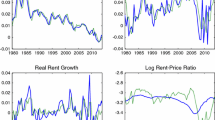Abstract
No study to date has empirically explored the characteristics associated with the market demand for real estate services. This study uses microeconomic theory and a panel data set of metropolitan statistical areas (MSAs) in the United States to uncover elasticity estimates of the market demand for real estate services with respect to own price, income, business cycle fluctuations, and other variables. The empirical findings yield a number of important insights regarding the market demand characteristics associated with real estate services. First, own-price elasticity equals roughly −1.20, suggesting an elastic demand for real estate services exists at the market level. Second, the income elasticity is found to be approximately 0.40, indicating that real estate services represent a normal good. Third, business cycle fluctuations, as represented by changes in the unemployment rate, are shown to influence the real estate services market but not to a significant extent. Finally, crime rates are shown to have no independent impact on the demand for real estate services despite earlier studies finding that crime reduces housing values and sales.


Similar content being viewed by others
Notes
One exception is Bates et al. (2014).
We assume PX represents the numeraire.
Conceptually, individual demands are first derived and then horizontally summed across all buyers in the same market. We are just saving a step in the theoretical deviation of market demand.
Reimbursement in the real estate industry is often based on commissions which is some percentage of the fixed sales price of the house or rental value of the office space. However, we must not forget that part of those proceeds are then paid out to real estate employees in the form of labor income. It is that portion of the reimbursement that we use to construct a relative index of the cost or price of providing real estate services in the various MSAs over time.
Any difference in c of equation 5 will be captured by the MSA fixed effects that are specified. We also allow F, labor’s factor share, to differ across MSAs and over time in response to changes in technology and other factors.
We could not use data before 2001 because figures for gross domestic product specific to the real estate sector are not available at the MSA level.
The rental and leasing industries include, for example, companies that rent or lease automobiles and furniture.
Another important consideration is the quality of the schools in the MSAs. We lack data on that variable, however.
We are unable to specify demographic factors such as age, race, and education because consistent data are unavailable for these variables over time at the MSA level. Since we are analyzing year-to-year or short-run effects and demographic factors change slowly over time, their omission from the analysis is likely to be relatively unimportant.
The importance of “social fabric” becomes more apparent later when we discuss the results regarding the impact of crime on the demand for real estate services.
Because of the time-fixed effects, it does not matter for the regression results if real estate GDP, real estate wage, and income per capita are measured in real (deflated by the national consumer price index) or nominal terms.
While reverse causation can be ruled out because of the constant returns assumption, misidentification cannot be ruled out in the case of the price elasticity of demand estimates. In particular, the various regression equations may be capturing different supply and demand equilibriums rather than tracing out an actual demand curve. We tried various instrumental variables to better isolate a demand relationship but were unable to find a plausible and strong predictor in the first stage regression. In any case, we note that the results for the other demand characteristics remain largely unchanged without the price term.
Multicollinearity doesn’t seem to pose much of a problem because the simple correlation between the various independent variables only exceeds 0.50 for the two crime rates. Also, the coefficient estimates on the main independent variables, such as price, income, and unemployment, remain largely intact when further controls are added sequentially.
Notice the positive and sometimes statistically significant coefficient estimate on the property crimes rate variable. Lynch and Rasmussen report a positive correlation between property crimes and housing prices and attribute that to higher property crime reporting rates in wealthier areas. Interestingly, the relationships between the other variables, such as price, income, unemployment and population, and real estate expenditures remain largely the same even without the MSA fixed effects and time trends.
However, we cannot rule out that crime affect housing values and sales but not the demand for real estate services.
References
Bates, L. J., Giaccotto, C., & Santerre, R. E. (2014). Is the real estate sector more responsive to economy-wide or housing market conditions? An exploratory analysis. Journal of Real Estate Finance and Economics. doi:10.1007/s11146-014-9491-y.
Boggess, L. N., Greenbaum, R. T., & Tita, G. E. (2013). Does crime drive housing sales? Evidence from Los Angeles. Journal of Crime and Justice, 36, 299–318.
Borcherding, T. E., & Deacon, R. (1972). The demand for the services of non-federal governments. American Economic Review, 62, 891–901.
Bowes, D. R., & Ihlanfeldt, K. R. (2001). Identifying the impacts of rail transit stations on residential property values. Journal of Urban Economics, 50(1), 1–25.
Cook, P.J. (2008). Assessing urban crime and its control: An overview. National Bureau of Economic Research Working Paper Series No. 13781.
Gibbons, S. (2004). The costs of urban property crime. Economic Journal, 114, F441–F463.
Linden, L., & Rockoff, J. E. (2008). Estimates of the impact of crime risk on property values from Megan’s laws. American Economic Review, 98(3), 1103–1127.
Lynch, A. K., & Rasmussen, D. W. (2001). Measuring the impact of crime on house prices. Applied Economics, 33(15), 1981–1989.
Pope, J. C. (2008). Fear of crime and housing prices: household reactions to sex offender registries. Journal of Urban Economics, 64(3), 601–614.
Pope, D. G., & Pope, J. C. (2012). Crime and property values: evidence from the 1990s crime drop. Regional Science and Urban Economics, 42, 177–188.
Schwartz, A. E., Susin, S., & Voicu, I. (2003). Has fallen crime driven New York City’s real estate boom? Journal of Housing Research, 14(1), 101–135.
Thaler, R. (1978). A note on the value of crime control: evidence from the property market. Journal of Urban Economics, 5(1), 137–145.
Wooldridge, J. M. (2002). Econometric analysis of cross section and panel data. Cambridge, MA: The MIT Press.
Zimring, F. E. (2007). The great American crime decline. New York: Oxford University Press.
Acknowledgments
Santerre thanks the Center for Real Estate and Urban Economic Studies at UConn for providing summer support. Both authors thank Melanie Carrales and Callan Swenson of the Bureau of Economic Analysis and Roberto Morales of the Bureau of Labor Statistics for helping us locate the necessary metropolitan data. Finally, we thank the anonymous referee of this journal for the helpful comments provided.
Author information
Authors and Affiliations
Corresponding author
Rights and permissions
About this article
Cite this article
Bates, L.J., Santerre, R.E. The Market Demand Characteristics Associated with Real Estate Services: Some Evidence from a Panel Data Set of MSAs. J Real Estate Finan Econ 53, 77–89 (2016). https://doi.org/10.1007/s11146-015-9522-3
Published:
Issue Date:
DOI: https://doi.org/10.1007/s11146-015-9522-3




